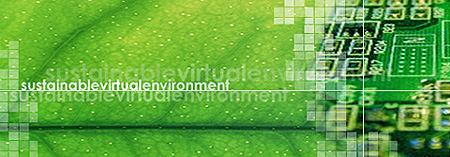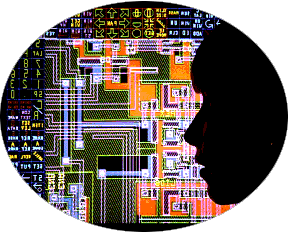
'Virtual'
Environment
A designed environment, electronically-generated from
within the built environment, which may have the appearance,
form, functionality and impact - to the person perceiving
and actually experiencing it - of a real, imagined and/or
utopian world.
A user may perceive and experience a Virtual Environment
from within, i.e. an 'immersive' e-Design approach,
or from the outside, i.e. a 'non-immersive' e-Design
approach.
Enhanced
Reality combines the 'real' and 'virtual' environments.
Social
Wellbeing
A general condition - in a community, society or culture
- of health, happiness, creativity, responsible fulfilment,
and sustainable development.
Sustainable
Human & Social Development
Development which meets the responsible needs, i.e.
the Human & Social Rights*, of
this generation - without stealing the life and living
resources from future generations, especially our children
... and their children.
*As
defined in the 1948 Universal
Declaration of Human Rights (UN OHCHR).
Sustainable
Design is the ethical design response to this concept.
'Built' Environment
Anywhere there is, or has been, an intrusion or intervention
by a human being in the natural environment, i.e. cities,
towns, villages, rural settlements, roads, transport,
bridges, tunnels, cultivated lands, lakes, rivers, coasts,
and the seas, etc. - including facilities, services,
information, the virtual environment and governance.
e-Functionality
A general term describing the capability of electronic
equipment for communication, transmission, or the processing
(including digital compression) and storage of data
entirely transferred, conveyed and received by wire,
by radio, or by optical or other electromagnetic means
.... and of an internet / intranet WebSite, a computer
operating system or any item of computer hardware or
software .... to function for the user with ease and
convenience, i.e. to meet specified design, construction
and reliability objectives.
Design,
construction and reliability objectives may be specified
by the user, the manufacturer, or the information society
service provider.
'Opt-In' Rule
The presentation, as standard procedure, of the positive
option to a data subject or information society service
recipient of freely giving a specific and informed indication
that he/she agrees to a particular process or transaction,
rather than the negative option of forcing that person
to withhold consent to such process or transaction.
This
rule is a mandatory procedure in ethical data processing
and information society service provision.

WSIS
2003 Declaration of Principles
Click
Here to Download PDF
(PDF File, 161kb)
WSIS
2003 Action Plan
Click
Here to Download PDF
(PDF File, 182kb)
Some
Characteristics of a Functional WebSite
This
is an interesting time to be involved in any aspect
of internet development - a component, and the beginnings,
of a viable and living 'virtual' environment. Since
2000-2001, much of the hype, hot air and hysteria surrounding
this new information and communication medium has disappeared.
It will take many years, however, before we fully understand
either the medium itself, or its vast potential.
We
can already, though, begin to sketch in some important
higher level design characteristics of a Functional
WebSite :
- it
complies with Authentication Guidelines, e.g.
the location(s) of the organization responsible for
the WebSite is/are identified, content is truthful
and verifiable, information sources are specified,
a named individual in the responsible organization
is contactable, etc ;
-
it is 'person-centred',
i.e. from the very start of the WebSite design process,
'real' users have been placed at the centre of creative
endeavours, and due consideration has been given to
their health, safety and welfare in the virtual environment
.....

-
it is Accessible
to the broadest range of potential users, in a language
of the user .... specific consideration has been given
to those people with a physical, mental, cognitive
or psychological impairment ;
- it
is respectful of user dignity, rights and
privacy .... with the 'opt-in' rule being a mandatory
procedure in its everyday operation ;
-
it is open and transparent, yet secure ;
-
it is designed with an acceptance that there are boundaries
to responsible free speech and other forms
of human expression ;
-
it is constructed and maintained in accordance with
the principles of SEED - Sustainable
Energy-efficient Environment-friendly
Development. The issues of energy-efficiency
and e-Waste require particular attention ;
-
it is current, i.e. regularly updated.
e-Inclusion
European Guideline Framework
Achievement
of Equality of Opportunity & Social Inclusion
For Every Person in the European Union (E.U.)
Removing
Physical Restrictions on Participation in Society
e-Research
Computer
& Virtual Environment Interface Technologies
e-Europe
Our
Objective in Europe must be ...
'...
a people-centred, inclusive and development-oriented
Information Society, where everyone
can create, access, utilize and share information and
knowledge, enabling individuals, communities and peoples
to achieve their full potential in promoting their Sustainable
Development and improving their quality of
life, premised on the purposes and principles of the
Charter of the United Nations and respecting fully and
upholding the Universal
Declaration of Human Rights.'
2003
UN WSIS Declaration of Principles
Some Relevant EU Secondary Legislation




